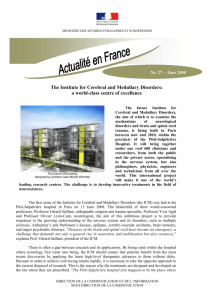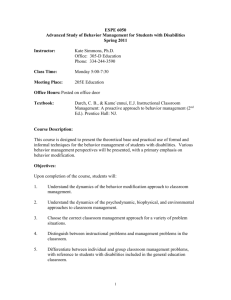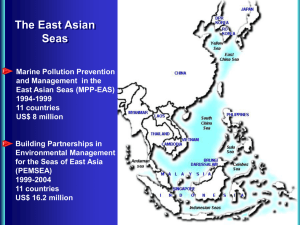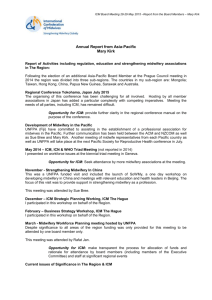Integrated Corridor Management: A Review on the Theory and Practice
advertisement
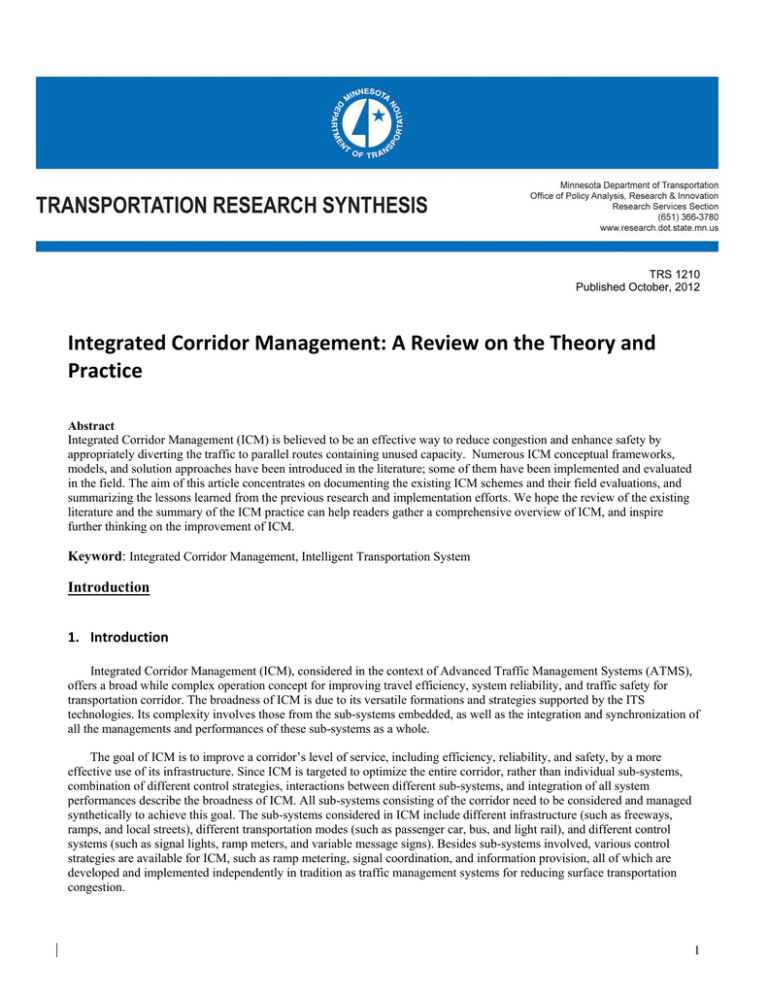
TRS 1210 Published October, 2012 Integrated Corridor Management: A Review on the Theory and Practice Abstract Integrated Corridor Management (ICM) is believed to be an effective way to reduce congestion and enhance safety by appropriately diverting the traffic to parallel routes containing unused capacity. Numerous ICM conceptual frameworks, models, and solution approaches have been introduced in the literature; some of them have been implemented and evaluated in the field. The aim of this article concentrates on documenting the existing ICM schemes and their field evaluations, and summarizing the lessons learned from the previous research and implementation efforts. We hope the review of the existing literature and the summary of the ICM practice can help readers gather a comprehensive overview of ICM, and inspire further thinking on the improvement of ICM. Keyword: Integrated Corridor Management, Intelligent Transportation System Introduction 1. Introduction Integrated Corridor Management (ICM), considered in the context of Advanced Traffic Management Systems (ATMS), offers a broad while complex operation concept for improving travel efficiency, system reliability, and traffic safety for transportation corridor. The broadness of ICM is due to its versatile formations and strategies supported by the ITS technologies. Its complexity involves those from the sub-systems embedded, as well as the integration and synchronization of all the managements and performances of these sub-systems as a whole. The goal of ICM is to improve a corridor’s level of service, including efficiency, reliability, and safety, by a more effective use of its infrastructure. Since ICM is targeted to optimize the entire corridor, rather than individual sub-systems, combination of different control strategies, interactions between different sub-systems, and integration of all system performances describe the broadness of ICM. All sub-systems consisting of the corridor need to be considered and managed synthetically to achieve this goal. The sub-systems considered in ICM include different infrastructure (such as freeways, ramps, and local streets), different transportation modes (such as passenger car, bus, and light rail), and different control systems (such as signal lights, ramp meters, and variable message signs). Besides sub-systems involved, various control strategies are available for ICM, such as ramp metering, signal coordination, and information provision, all of which are developed and implemented independently in tradition as traffic management systems for reducing surface transportation congestion. 1 Synthesizing all the components inside an ICM system, including infrastructures and management strategies, is a complex process. In an ICM system, a basic principle is to take full advantage of the unused capacity contained in the corridors by parallel routes, through various strategies. However, the unused capacity varies greatly along with the changes of demand patterns at different routes, in different transportation modes, at different times. In addition, the booming ITS technology offers such a great flexibility in management methods to handle the dynamics. Depending on different control strategies and objectives considered, tremendous research efforts have been conducted in the literature, focusing on formulating theoretical models, developing efficient solution methods, and evaluating the effectiveness of deployed ICM systems. The broadness and complexity of ICM illustrate the difficulties of designing effective ICM schemes. Most existing studies in the literature are on theory development. Researchers gradually put their efforts to the operation issues along with the maturation of ICM theories. As indicated by the title, this paper reviews the theoretical advances on methodological side, including ICM frameworks, analytical models, and solution approaches, as well as the practical advances on operational side, including the technologies applied, field implementations, and evaluations of ICM systems. This paper will specifically emphasize the research on the integration of freeways and signalized arterials, not only because it has attracted the most attention in the literature, but because it will bring us the greatest challenges as well as benefits. This paper is organized as follows. The next section provides a brief summary of the background of ICM, including its definition and fundamental principles. Section 3 reviews the theoretical studies of ICM, which are categorized based on model focus. Section 4 describes the ICM advances in practice, including those strategies are implemented or being tested, as well as the lessons learned from field implementations. Section 5 presents current challenges facing to the ICM decisionmakers and opportunities for researchers. The final section summarizes concluding comments. 2. Background Integrated control is not a new traffic management concept. The earliest research on integrated control at network level can be traced back to 1970s. Robertson and Vincent (1974 ) first consider the integration of bus schedules and signal timings. Later, van Aerde and Yagar (1988a) are the first who clearly addressed the importance of integrated control and discussed the required characteristics to operate an integrated control system. Van Aerde and Yagar (1988b) further propose a conceptual ICM approach, called INTEGRATION, which applies dynamic optimal route guidance as the control strategy in an integrated network. Their assumption of on-board driving information systems provides wide range applications by employing more sophisticated traffic controls. After van Aerde and Yagar’ work, researchers have established various integrated traffic control frameworks, models, and solution approaches. The U.S. government notices the potential benefits of ICM and starts to document the research on this topic. In 2005, the U.S. Department of Transportation’s (USDOT) Intelligent Transportation Systems (ITS) program launched the ICM Systems initiative1, whose ultimate goal is “to provide the institutional guidance, operational capabilities, and ITS technology and technical methods needed for effective Integrated Corridor Management Systems”. The initiative further propels the research on ICM in a regulated way, with the refined definitions for transportation corridor and ICM. 2.1 Definitions With a broad definition of transportation corridor, tremendous studies on integrated control strategy can be classified into ICM. Papageorgiou (1995) systematically modeled ICM strategies, where a traffic corridor is simply defined as “a general highway network including both motorways and urban roads”. Papageorgiou’s definition is oriented to single-modal corridor control that is not sufficient to cover the broadly discussed ICM nowadays. A wider scope should be covered in the definition. In the ICM Program Plan, a succinct definition of transportation corridor is provided as “a combination of discrete parallel surface transportation networks (e.g., freeway, arterial, transit networks) that link the same major origins and destinations. It is defined operationally rather than geographically or organizationally”. This definition emphasizes the operation aspect in a transportation corridor, and is more suitable in discussing ICM. 1 Details about ICM Systems initiative are available at http://www.its.dot.gov/icms/ 2 The simple definitions of corridor are not sophisticated enough to highlight the special characteristics and key elements of a corridor from the operational perspective of ICM. Responding to this need, Reiss et al. (2006) provide a refined definition of transportation corridor in their ICM initiative report: Corridor–A largely linear geographic band defined by existing and forecasted travel patterns involving both people and goods. The corridor serves a particular travel market or markets that are affected by similar transportation needs and mobility issues. The corridor includes various networks (e.g., limited access facility, surface arterial(s), transit, bicycle, pedestrian pathway, waterway) that provide similar or complementary transportation functions. Additionally, the corridor includes cross-network connections that permit the individual networks to be readily accessible from each other. After we clarify the study subject at corridor level, it is easier to categorize the ICM strategies. In early research, no clear definition of ICM was given. Van Aerde and Yagar (1988b) simply describe the integrated management as a way “to jointly optimize the combined network as an integrated unit”. In the ICM Program Plan, ICM is defined as “the coordination of individual network operations between adjacent facilities that creates an interconnected system capable of cross-network travel management.” To differentiate the ICM from other advanced traffic management systems, Reiss et al. (2006) report a refined definition of ICM as follows. Integrated Corridor Management – ICM consists of the operational coordination of multiple transportation networks and cross-network connections comprising a corridor and the coordination of institutions responsible for corridor mobility. The goal of ICM is to improve mobility, safety, and other transportation objectives for travelers and goods. ICM may encompass several activities, for example: Cooperative and integrated policy among stakeholders responsible for operations in the corridor. Concept of operations for corridor management. Improving the efficiency of cross‐network junctions and interfaces. Mobility opportunities, including shifts to alternate routes and modes. Real‐time traffic and transit monitoring. Real‐time information distribution (including alternate networks). Congestion management (recurring and non‐recurring). Incident management. Travel demand management. Public awareness programs. Transportation pricing and payment. The comprehensive definition of ICM summarizes the main attributes of ICM. It emphasizes the dependence and interaction between the activities imposed on sub-systems of a transportation corridor. The list of activities of ICM also provides a natural classification of ICM-related research topics in the literature. 2.2 Fundamentals ICM Program Plan emphasizes three fundamental elements in implementing successful corridor management: Institutional integration, operational integration, and technological integration. As noted in the ICM Systems initiative, the operational integration is the foundation of institutional and technological integrations. Thus, we will focus on reviewing the theoretical development in operational integration, and briefly review the works on the institutional and technological integrations in practice. From the operation perspective, a typical ICM system usually contains a set of information processing procedures and management processes, which support decision makers to identify appropriate controls. Since the role of information in ICM shifts to support the whole corridor rather than individual sub-systems, the information processing procedures in ICM need to integrate more components than those in individual management sub-systems, especially when more sub-systems are involved. For example, it may need to gather travelers’ choice and their transition information between different transportation modes. Gathering reliable data is in essence for analyzing and delivering the underlying information to 3 management processes (Cronin et al. 2010). Current data collection and information processing procedures in ICM heavily depend on applications of advanced information and communication technologies. Therefore, the advance of information processing modules in ICM is (highly) correlated with the advance of ITS technologies. With quick advances in communication technologies, an ICM system is able to archive robust and reliable data by low-cost data collection methodologies. However, the current advanced information has not been effectively used and integrated for ICM, mainly due to the absence of reliable forecasting methods and decision-support methodologies (based on existing data). There is a strong need for developing forecast and management architectures for ICM based on existing advanced information and communication technologies. Responding to this need, tremendous research efforts on ICM have been put on the development of various management methodologies in ICM. Due to the complexness and the broadness in composition of ICM system, the proposed methodologies are constructed from various perspectives. 3. Model Development In current practice, existing ICM systems rely on reliable well-calibrated models (Cronin et al. 2010). Significant research effort has been paid to the analysis, modeling, and simulation methodologies. Based on the focus of those models, existing ICM models can be roughly categorized into two groups. The first group mainly focuses on the information provision and travelers’ response, such as providing travel time information of different routes through Variable Message Sign (VMS), and the models are more macroscopic; while the second group emphasizes the traffic evolution and interaction, which is more microscopic. 3.1 Focus on information provision and travelers’ response Route guidance via certain media, such as Variable Message Sign (VMS) or on-board navigation system, is considered as an effective way to advise motorists to better use network capacities. This group of study was first conducted by Papageorgiou (1990), in which a macroscopic modeling framework for dynamic modeling and control of traffic networks was presented under time-varying demand conditions. The traffic network may include both freeways and urban roads and the control measures include individual and/or collective route guidance, signal setting and ramp metering. This approach was extensively studied and extended by following researchers. Hawas & Mahmassani (1995) developed a procedure for real-time route guidance in congested vehicular traffic networks. The approach collects information from a set of local controllers scattered or distributed in the network and utilizes this information to guide vehicles. Messmer & Papageorgiou (1995) proposed a nonlinear optimization method to control motorway networks via Variable Message Signs (VMS). The problem is formulated as a dynamic, nonlinear, discrete-time optimal control problem with constrained control variables and can be solved by gradient based search methods. Ben-Akiva et. al (1997), used the DynaMIT (Dynamic Network Assignment for the Management of Information to Travelers) to generate real-time prediction-based guidance information. Pavlis & Papageorgiou (1999) and Minciardi (2001) further developed a simple decentralized feedback strategy for route guidance in traffic networks, where the measurable instantaneous travel times were used to generate control decisions. The objective of this type of models is to minimize the difference among the travel times from each origin node to all the possible destinations through the available routes in the network. Similar research work can be found at Yang and Yagar,1995, Abdelghany et al., 1999, Mahmassani, 2001, Adler & Blue, 2002, Wang and Papageorgiou, 2002, Hamdar et al., 2006 and etc. With the provided route guidance, different drivers may react differently. In essence, motorists’ choices are the most important parts to determine eventual performance. To accommodate that, there are a group of studies focusing on driver compliance. Peeta et al. (2000) investigated the effect of different message contents on driver response under VMS. The analysis was done through an on-site stated preference user survey and Logit models were developed for drivers’ diversion decisions. The result shows that content in terms of the level of detail of relevant information significantly affects drivers’ willingness to divert. Similarly, Kattan et al. (2010) conducted a survey of 500 Deerfoot Trail commuters in Calgary, Canada to examine the factors affecting drivers’ compliance with VMSs. The results show that, 63.3% of drivers alter their trip plans with the information provided, comparing with 36.7% of drivers who did not alter their route. Regarding compliance model development, Peeta and Gedela (2001) proposed a VMS control heuristic framework, which ensures consistency with driver diversion response behavior. More recently, Paz and Peeta (2009) developed a fuzzy control modeling approach to determine the associated behavior-consistent information-based network control strategies. The approach can provide more robust performance compared to the standard user or system optimal information strategies. Lee et al. (2010) explored the factors affecting alternative route choices of car drivers with VMSs by adopting a method called LOTUS. The study pointed out that travel-time saving is not the single dominant factor for driver route choice under information provision. 4 3.2 Focus on traffic evolution and interaction The traffic evolution and interaction between sub-systems also attract many researchers’ attention. In 1993, Chang et al. (1993) presented a dynamic system-optimal control model (DSOCM) for commuting corridors which consist of both freeway and surface streets. The proposed model considers the complex interactions among the freeway, surface street and diversion flows. Optimal time-dependent ramp metering rates and signal settings can be obtained by solving the model. Stephanedes and Kwon (1993) introduced an adaptive demand-diversion predictor which specifically considers the influence of traffic diversion to ramp metering and intersection signal timings. Following that, Papageorgiou (1995) developed an integrated control approach for traffic corridors including both freeways and signalized arterials based on the store-and-forward modeling philosophy. The control objective is to minimize the total delay or the total time spent in the network. The formulated optimal-control problem may provide traffic-responsive queue management, particularly under saturated traffic conditions. Later, Wu and Chang (1999) proposed a control model in an on-line environment which integrates ramp metering, intersection signal timing and off-ramp diversion under non-recurrent congestion. The approach models traffic state evolution on surface streets and estimate time-dependent model parameters adaptively with real-time traffic measurements. Kotsialos et al. (2002) proposed a generic formulation in the format of discrete-time optimal control problem and it can be solved by a feasible-direction algorithm. More recently, Liu and Chang (2010) and Liu et al. (2011) introduced a multiobjective optimization model to maximize the utilization of the available corridor capacity. Because of model complexity, the optimal diversion rates can be obtained through a genetic algorithm-based technique. This group of models specifically considers the queue formation and dispersion among different systems, however, the complexity of formulation largely limits the practical implementation. 4. Operations In this section, we will review those ICM strategies which are implemented or being tested in operation, as well as the lessons learned from field implementations. ITS aims to use advanced technologies to improve transportation on many levels, such as reduce congestion, enhance safety, mitigate the environmental impacts of transportation systems, enhance energy performance, and improve productivity (Sussman et al., 2000). A brief review on ITS technologies of existing transportation infrastructures will be first given in the following. 4.1 ITS technologies As said, the operation of Integrated Corridor Management (ICM) highly depends on the development of Intelligent Transportation System (ITS) because there are a lot of information processing and information sharing between different subsystems. The integration of different ITS infrastructures just constructs the base for various ICM control strategies. The ITS in arterial management mainly includes two areas, the adaptive control strategies (ACS) and the advanced traveler information system (ATIS). The ACS optimizes intersection signal timing plans in real time, based on current traffic conditions and demand. Representative ACS systems include SCOOT (Hunt et al., 1982), OPAC (Gartner, 1983), RHODES (Sen & Head, 1997) and etc. These adaptive control system works great under light and medium traffic conditions, however, the performance deteriorates in case of saturated traffic conditions. ATIS for arterials provides information on arterial conditions (e.g., travel speeds, travel time, incidents) to travelers through certain media. On freeway management, ramp metering is a major and highly effective management tool, which can reduce the traffic congestion on freeway (Sussman et al., 2000). These metering strategies can be divided into two groups, i.e. fixed time strategies, such as Wattleworth, 1965 and reactive metering strategies, such as Papageorgiou et al., 1998. These strategies have been extensively evaluated not only in simulation but also in field (Chang and Stephanedes, 1993, Haj-Salem and Papageorgiou, 1995, Zhang and Recker,1999, Hasan and Ben-Akiva, 2003 Tian, 2007 and Ahn et al., 2007). Variable speed limits and dynamic lane controls continue to show promise, but are not yet widely deployed in the United States. Variable Message Sign (VMS) is a widely used tool to provide information to drivers, allowing drivers to re-route before arriving to the network bottleneck. 4.2 Practices and Pioneer sites 5 In practice, the application of the ICM concept is still at the very early stage. Because different transportation infrastructures usually belong to different agencies, communication and policy barriers have restricted most of the ICM application within the same traffic mode. Most of the work related to cross-modal integration still remains at the policy research level (Alm et al., 2008), such as cost-benefit analysis, incentive analysis and agreement analysis, and the evaluations are still based on simulation studies (Alexiadis, 2008). From fall 1994 through spring 1999 in Irvine, California, a systematic evaluation of the performance and effectiveness of an integrated corridor-level adaptive control system was attempted. The California Department of Transportation (Caltrans), the city of Irvine, and two private-sector consultants were involved in the field test. Because of the failure of any of the planned technologies to be successfully implemented in the field, the test failed to provide a technical evaluation on the integrated system. However, two most valuable lessons were learned through the process: “It is important to incorporate detailed technical specifications in contract documents” and “there is a strong need for complete technical review and an appropriate level of technical understanding on the part of the contracting agency.” (MacCarley et al., 2002) Later, a new integrated traffic-responsive urban corridor control strategy IN-TUC (integrated traffic-responsive urban control) was developed and applied to the M8 corridor network in Glasgow,Scotland, which include signal control, ramp metering, and VMS control. The results of the preliminary simulation investigations as well as the results of the field implementation and evaluation of the strategy seem promising (Diakaki et al., 2000). More recently, Perugu et al. 2007 developed an Integrated Corridor Control system with Access management (IUCC-ACCESS). The heuristic algorithm integrates SCOOT algorithm, and BOTTLENECK-access metering algorithm with dynamic rerouting for selected time horizon. , a simulation-based test bed was built to test the proposed model and the test results showed the effectiveness of improve network performance. In 2005, the U.S. Department of Transportation’s (USDOT) Intelligent Transportation Systems (ITS) program launched the ICM Systems initiative and eight pioneer sites were selected. The eight sites are located in Oakland and San Diego, CA; Dallas, Houston, and San Antonio, TX; Montgomery County, MD; Seattle, WA; and Minneapolis, MN. These pioneer sites are all recognized leaders in the area of congestion management and the corresponding corridors are already equipped with advance ITS infrastructures, such as HOV/HOT lanes, real time arterial signal and ramp metering control, rapid transit services and etc (FHWA, 2007) . All eight sites participated in the ICM Initiative's initial phase (concepts of operations and system requirement), which was completed in 2007 (FHWA, 2007). These sites have developed multimodal ICM strategies that apply new institutional and operational approaches and advanced technologies to existing infrastructure. In late 2009, Dallas, TX and San Diego, CA were selected by the U.S. DOT to demonstrate their ICM systems. Dallas will integrate the regional systems and operations along the US-75 corridor using a decentralized approach. Travelers will have access to realtime information about traffic and travel times, public transit, and parking availability through wireless and web-based alerts as well as dynamic message signs on the roads (FHWA, 2008a). San Diego aims to proactively and collaboratively manage the I-15 corridor to maximize transportation system performance. Through collaboration among the corridor’s institutional partners, the system will enable travelers the opportunity to make convenient shifts among modes and routes (FHWA, 2008b). 5. Challenges and Opportunities 5.1 On modeling side The development of ICM models has two major challenges: the origin – destination information estimation and drivers’ compliance rate estimation. Most existing models require the O-D matrix as inputs to generate specific control decisions, however, as well known, the estimation of network O-D information is extremely difficult, especially under congested scenarios. How to successfully get time-dependent network O-D information will still be a challenging task in the ICM domain, since it determines the possibility of practical implementation for most developed models. On the other hand, even if the optimal control strategies can be generated, motorists’ reaction to these control decisions is essentially the key to the final network performance. A more robust and accurate real-time estimation model is desired to estimate drivers’ compliance rates to given control strategies. 5.2 On operation side The implementation of ICM control strategies is mainly restricted by two factors: the lack of real time traffic data collection and the communication barriers between different agencies. The problem of real time data collection becomes 6 more prominent in the area of arterial management, due to the absence of ITS infrastructures. More implementation of advanced data collection system, which can provides the most updated traffic information (travel time, speed, incident and etc.), is still an important step to achieve ICM goals. The communication barriers between transportation agencies (arterial, freeway, transit and etc.), due to either policy limitation or technical problem, still largely undermine the base of ICM. The construction of a central system, which can integrate all the real time traffic information between different agencies and dispatch the optimal control strategies to sub-systems, still needs a huge effort from various departments. Further, through field implementation evaluations, we can see that the considerations on ICM should go far beyond quantitative cost-benefit analysis in proposed strategies and infrastructure investment. Some qualitative factors, such as enhancing intermodal transition reliability, improving freight mobility, or reducing environmental impacts to better support livability and sustainability, should be considered in the future as well. 6. Concluding Remarks In general, the Integrated Corridor Management (ICM) is a comprehensive and challenging problem. It consists of the operational coordination of multiple transportation networks (freeway, arterial, transit, bicycle, pedestrian pathway and etc.) and cross-network connections. Due to the complexness and the broadness of the ICM system, control models are constructed from various perspectives. Based on the focus of those models, existing ICM models can be roughly categorized into two groups. The first group mainly focuses on the information provision and travelers’ response (more macroscopic) and the second group emphasizes the traffic evolution and interaction (more microscopic). How to accurately estimate the origin – destination information and drivers’ compliance rate in real time is the key problem waiting to be solved for existing ICM models. In practice, due to the communication and policy barriers between different agencies, the application of the ICM concept is still at the very early stage. Most work remains at the policy research level and the evaluations are still based on simulation studies. In 2005, the USDOT Intelligent Transportation Systems (ITS) program launched the ICM Systems initiative and eight pioneer sites were selected to generate the concept of ICM operation. Later, Dallas, TX and San Diego, CA were selected to demonstrate their ICM systems. Limited field experience has already shown that, in order to successfully implement ICM, different transportation agencies must cooperate with each other and share resources and real time traffic information. Eventually, the integrated system will improve transportation efficiency, robustness and flexibility, which is very promising, especially under the increasing trend of traffic demand. References Abdelghany K. F.,Valdes, D.M., Abdelfatah, A.S., Mahmassani, H.S. 1999. Real-Time Dynamic Traffic Assignment and Path-Based Signal Coordination; Application to Network Traffic Management. TransportationResearch Record 1667, 67-76. Adler, J.L., Blue, V.J. 2002. A cooperative multi-agent transportation management and route guidance system . Transportation Research Part C 10(5-6), 433-454. Ahn, S.,Bertini, R.L.,Auffray, B., Ross, J.H.,Eshel, O. 2007. Evaluating benefits of system wide adaptive ramp-metering strategy in Portland, Oregon. Transportation Research Record 2012, 47—56. Alexiadis, V. 2008. Integrated Corridor Management Analysis, Modeling, and Simulation Results for the Test Corridor. Technical report, Federal Highway Administration Alm, E. and Lingham, V. and Benouar, H. and Ban, X.J. and Chu, L. 2008.An Integrated Methodology for Corridor Management Planning.Transportation Research Board 87th Annual Meeting. Ben-akiva, M., Bierlaire, M., Bottom, J., Koutsopoulos, H. and Mishalani, R. 1997. Development of a Route Guidance Generation System for Real-Time Application. 8th IFAC Symposium on Transportation Systems, Chania, Creta, Greece Chang, G.-L., Ho, P.-K., Wei, C.-H. 1993. A dynamic system-optimum control model for commuting traffic corridors. Transportation Research Part C 1(1), 3-22. Chang, K., Stephanedes, Y. J. 1993. Optimal control of freeway corridors. ASCE Journal of Transportation Engineering 119(4), 504–514. Cronin, B., Mortensen, S., Sheehan, R., Thompson, D. 2010.Integrated Corridor Management. Public Roads 74(3), 6–11. Dell’Olmo, P.,Mirchandani,P.B. 1995. REALBAND: An Approach for Real-Time Coordination of Traffic Flows on a Network. Transportation Research Record1494, 106-116. Diakaki, C., Papageorgiou, M., McLean, T. 2000. Integrated traffic-responsive urban corridor control strategy in Glasgow, Scotland: Application and Evaluation. Transportation Research Record 1727, 101-111. 7 FHWA, 1988. TRANSYT User’s Manual (Release 6), US Department of Transportation,Federal Highway Administration, Washington, D.C. FHWA. 2005.Integrated Corridor Management System (ICMS) Work Plan. http://www.itsdocs.fhwa.dot.gov/icms/icms workplan.htm. accessed 2005. FHWA. 2007. Managing Congestion with Integrated Corridor Management. FHWA-JPO-07-025 FHWA, 2008a. Concept of Operations for the US-75 Integrated Corridor in Dallas, Texas. FHWA-JPO-08-004 FHWA, 2008b. Concept of Operations for the I-15 Corridor in San Diego, California. FHWA-JPO-08-009 Gartner, N. H. 1983. OPAC: A demand-responsive strategy for traffic signal control. U.S. Department of Transportation, Washington, DC, Transportation Research Record 906, Haj-Salem, H., Papageorgiou, M. 1995. Ramp metering impact on urban corridor traffic: Field results. Transportation Research Part A 29(4), 303–319. Hamdar, S.H., Eisenman, S.M., Mahmassani, H.S. 2006. Evaluation of Operational Strategies for Integrated Corridor Management. Transportation Research Board 85th Annual Meeting, Paper number 06-3096. Hasan M., Jha, M., Ben-Akiva.,M. 2003.Evaluation of ramp control algorithms UsingMicroscopic Simulation. Transportation Research Part C 10(3), 229-256. Hawas, Y. and Mahmassani, H.S. 1995. A Decentralized Scheme for Real-time Route Guidance in Vehicular Traffic Networks. Intelligent Transport Systems World Congress, : Yokohama, Japan Head, K.L., Mirchandani, P.B., Sheppard,D. 1992.Hierarchical Framework for RealTime Traffic Control. Transportation Research Record 1360, 82-88. Hunt P.B., Robertson D.I., Bretherton R.D., 1982. The SCOOT on-line traffic signal optimization technique (Glasgow). Traffic Engineering & Control23(4) 190-192. Kattan, L., Nurul Habib, K. M., Nadeem, S.and Islam, T. 2010. Modeling Travelers’ Responses to Incident Information Provided by Variable Message Signs in Calgary, Canada. Transportation Research Record, vol.2185, pp 71-80. Kotsialos, A.,Papageorgiou, M.,Mangeas, M. Haj-Salem, H. 2002.Coordinated and integrated control of motorway networks via non-linear optimal control. Transportation Research Part C 10(1), 65–84. Lee, C., Ran, B., Yang, F. and Loh, W. 2010. A Hybrid Tree Approach to Modeling Alternate Route Choice Behavior with Online Information," Journal of Intelligent Transportation Systems, vol. 14, pp. 209-219. Liu, Y., Chang, G.L. 2010. A generalized corridor diversion control model for freeway incident management.89th TRB Annual Meeting Proceedings CDROM, 10-2969. Liu, Y. and Chang, G. and Yu, J. 2011.An Integrated Control Model for Freeway Corridor Under Nonrecurrent Congestion. IEEE Transactions on Vehicular Technology 60(4), 1404-1418. Ma, J.,Nie, Y., Zhang, H.M.,2007.Solving the Integrated Corridor Control Problem Using Simultaneous Perturbation Stochastic Approximation. Transportation Research Board 86th Annual Meeting. MacCarley, C.A., Mattingly, S.P., McNally, M.G., Mezger, D., Moore, J.E. 2002. Field Operational Test of integrated freeway ramp metering/arterial adaptive signal control lessons learned in Irvine, California. Transportation Research Record 1811, 76—83. Mahmassani, H.S., 2001. Dynamic network traffic assignment and simulation methodology for advanced system management applications. Networks and Spatial Economics 1(3/4), 267–292. Mahmassani, H.S., Sbayti, H.A. Zhou, X.,2004. DYNASMART-P Version 0.930.7User’s Guide. Prepared for U.S. Department of Transportation. Messmer, A. and Papageorgiou, M. 1995. Route Diversion Control in Motorway Networks via Nonlinear Optimization. IEEE Transactions on Control Systems Technology, Vol. 3, No. 1, 144-154 Minciardi, R. 2001. A Decentralized Optimal Control Scheme for Route Guidance in Urban Road Networks. IEEE Intelligent Transportation Systems Conference Proceedings, Oakland, CA Papageorgiou, M. 1990. Dynamic modeling, assignment, and route guidance in traffic networks. Transportation Research Part B24, 471-495. Papageorgiou, M. 1995. An integrated control approach for traffic corridors. Transportation Research Part C3(1),19-30. Papageorgiou, M.,Diakaki,C.,Mclean, T., 1997. Simulation studies of integrated corridor control in Glasgow. Transportation Research Part C 5(3), 211-224. Papageorgiou, M., Haj-Salem,H.,Middelham, F. 1998.ALINEA Local Ramp Metering:Summary of Field Results. Transportation Research Record 1603, 13-20. Papageorgiou, M., Diakaki, C., Dinopoulou, V., Kotsialos, A. and Wang, Y. B. 2003. Review of road traffic control strategies. Proceedings of the IEEE, vol. 91, pp. 2043-2067. Pavlis, Y. and Papageorgiou, M. 1999. Simple Decentralized Feedback Strategies for Route Guidance in Traffic Networks. Transportation Science. Vol. 33, No. 3, 264 – 278 8 Paz, A., Peeta, S. 2009. Behavior-consistent real-time traffic routing under information provision. Transportation Research Part C 17(6), 642—661. Peeta, S. and Gedela, S., 2001. Real-time variable message sign-based route guidance consistent with driver behavior. Transportation Research Record, vol. 1752, pp. 117-125. Peeta, S., Ramos, J. L. and Pasupathy, R. 2000. Content of variable message signs and on-line driver behavior. Transportation Research Record, vol. 1725, pp. 102-108. Perugu, H.C., Wei, H.,Kashayi, N.C., 2007. Heuristic System Model and Algorithms for Integrated Urban CorridorTraffic Control System with Access Management Measures. Transportation Research Board 86th Annual Meeting, 07-1515. Reiss, R., Gordon, R., Neudorff, L., Harding, J. 2006. Integrated Corridor Management Phase I Concept Development and Foundational Research: Task 3.1 Develop Alternative Definitions. Report No. FHWA-JOP-06-034. United States Department of Transportation ITS Joint ProgramOffice, Federal Highway Administration, Federal Transit Administration. April11, 2006 Robertson, D.I., Vincent, R.A. 1974.Bus priority in a network of fixed-time signals. Proceedings of 6th International Symposium on Transportation andTraffic Theory, 285-306. Sydney. Robertson, D. Bretherton,R. 1991. Optimizing networks of traffic signals in real time — The SCOOT method. IEEE Transaction on Vehicular Technology 40(1), 11–15. Sen, S. and Head, L. 1997. Controlled optimization of phases at an intersection. Transportation Science, vol. 31, pp. 5–17. Stephanedes, Y.J. and Kwon, E. 1993. Adaptive demand-diversion prediction for integrated control of freeway corridors. Transportation Research Part C 1(1), 23-42. Sussman, J.M., et al. 2000. “What Have We Learned About ITS?” Report No. FHWA-OP-01-006. Federal Highway Administration, U.S. Department of Transportation. Washington, DC. Tian, Z. 2007. Modeling and Implementation of an Integrated Ramp Metering-Diamond Interchange Control System. Journal of Transportation Systems Engineering and Information Technology 7(1), 61—69. Van Aerde, M., Yagar, S. 1988a. Dynamic integrated freeway/traffic signal networks: Problems and proposed solutions. Transportation Research Part A 22(6), 435—443. Van Aerde, M., Yagar, S. 1988b. Dynamic integrated freeway/traffic signal networks: A routing-based modeling approach. Transportation Research Part A 22(6), 445-453. Van den Berg, M., De Schutter, B.,Hegyi, A., Hellendoorn, J. 2001 Model predictive control for mixed urban and freeway networks. Transportation Research Record 1748, 55–65. Wang, Y. and Papageorgiou, M. 2002. A Predictive Feedback Routing Control Strategy for Freeway Network Traffic. Proceedings of the American Control Conference, Anchorage, AK Wattleworth, J. A. 1965 “Peak-period analysis and control of a freeway system,” Highway Res. Board, Washington, DC, Highway Research Record 157 Wu, J., Chang, G.L.1999. An integrated optimal control and algorithm for commuting corridors. International Transactions in Operational Research 6(1), 39-55. Yang, H. and Yagar, S. 1995. Traffic assignment and signal control in saturated road networks. Transportation Research Part A 29(2), 125—139. Zhang, H.M., Recker, W.W. 1999. On optimal freeway ramp control policies for congested traffic corridors.Transportation Research Part B 33, 417-436. Summary 9

